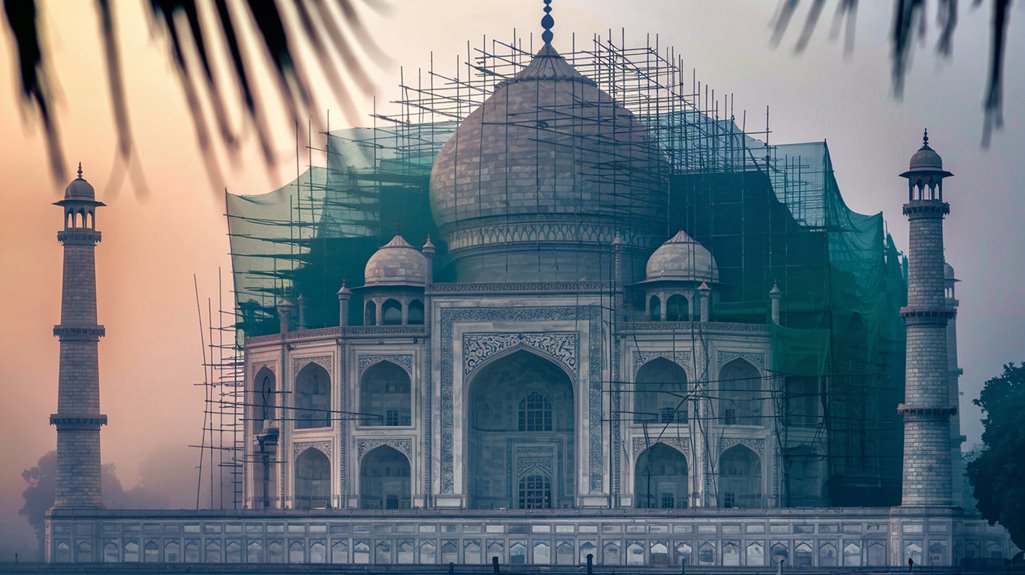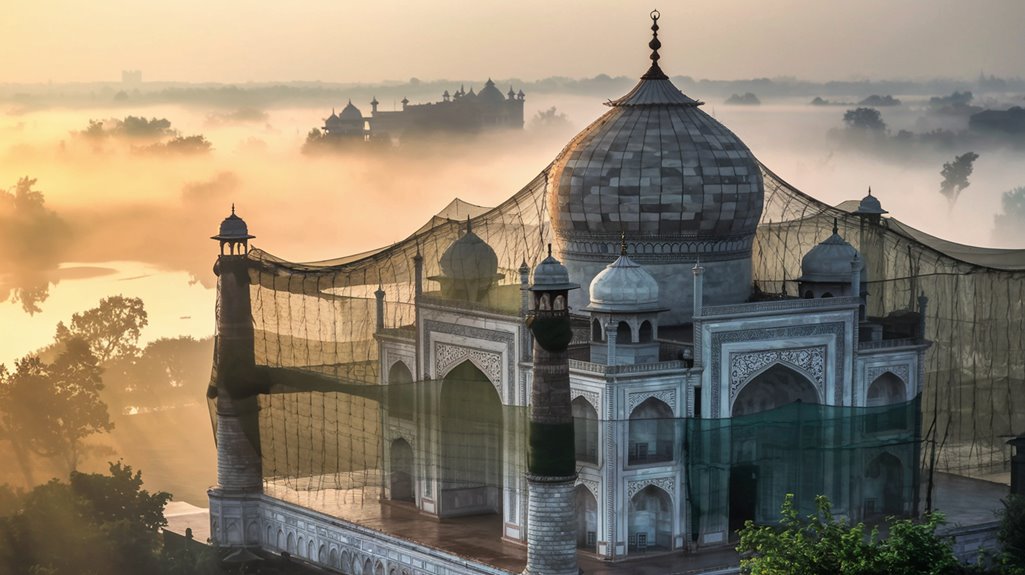The Taj Mahal Was Camouflaged During World War II
Like Odysseus concealing his troops within the Trojan Horse, the British military orchestrated one of history's most remarkable architectural disguises. You've probably marveled at photos of the Taj Mahal's pristine white marble and perfect symmetry, but you might not know that this iconic monument once disappeared beneath a clever wartime deception. The story of how bamboo scaffolding and artificial foliage transformed India's crown jewel into an unremarkable hillside reveals an ingenious plan to protect cultural heritage from aerial destruction.
The Wartime Threat to India's Crown Jewel

As World War II intensified in the early 1940s, India's most cherished monument faced an unprecedented threat. The Taj Mahal's wartime significance extended beyond its cultural value, as its location near military and industrial centers in Agra made it vulnerable to enemy attacks. Shah Jahan's masterpiece was commissioned in 1631 as a testament of love for his wife.
You might wonder why the Japanese forces would target this architectural masterpiece. As part of British-controlled India during the war, the monument became a potential strategic target.
The Japanese military's advance through Southeast Asia brought the threat of aerial bombardment closer to India's shores. The British colonial government recognized that destroying the Taj Mahal would deal a devastating blow to Indian morale and cultural heritage. Today, this white marble mausoleum continues to face different threats, though now from environmental pollution rather than warfare.
This realization prompted them to take extraordinary measures to protect one of the world's most recognizable landmarks from potential destruction.
Engineering a Bamboo Shield: The Camouflage Strategy
When British military strategists needed to protect the Taj Mahal from aerial attacks, they turned to an ingenious yet simple solution: bamboo scaffolding.
The engineering feat involved constructing an elaborate shield around the 200-foot-tall dome using India's abundant bamboo resources. They chose bamboo for its flexibility, durability, and lightweight properties, making it perfect for creating a temporary structure without damaging the monument. Bamboo was particularly suitable as a renewable resource that could be quickly sourced and replaced as needed.
The scaffolding completely covered the iconic landmark, transforming its appearance into what looked like a massive pile of vegetation from above. The elaborate disguise was implemented in 1942 during World War II.
The camouflage effectiveness proved remarkable, as the structure successfully deterred potential bombing raids during World War II.
You'll find it interesting that this protective strategy wasn't just a one-time solution – similar techniques were later employed during the Indo-Pakistani conflicts of 1965 and 1971.
British Efforts to Protect Cultural Heritage
During World War II, British authorities launched a thorough campaign to safeguard cultural treasures across their territories, with the Taj Mahal's protection serving as their most ambitious undertaking.
The British collaboration with Indian officials stemmed from hard-learned lessons of World War I, when German forces had damaged numerous cultural sites.
You'll find that their cultural preservation efforts weren't limited to India alone. Their understanding of the need for disaster management plans guided their systematic approach to protecting heritage sites.
Working alongside organizations like the Monuments Men in Europe, British forces helped establish protocols for protecting historical landmarks from aerial bombardment.
They drew upon their experience from the German warship Emden's attack on Madras, recognizing that iconic monuments could become prime targets.
The protective strategy included covering the Taj Mahal's distinctive dome with bamboo scaffolding to deceive enemy aircraft.
This extensive approach to heritage protection would later influence how cultural sites were safeguarded during the Indo-Pakistani wars and beyond.
Beyond World War II: Later Uses of Monument Camouflage
Since the pioneering efforts to protect the Taj Mahal during World War II, monument camouflage techniques have evolved markedly.
Today's modern camouflage approaches combine historical preservation needs with advanced technological solutions, ensuring cultural landmarks remain protected while maintaining their integrity. Drawing from wartime experience, scale models and sketches were essential tools that artists used to plan effective camouflage strategies.
Early wartime techniques, like using earthy tones and browns, laid the groundwork for modern camouflage strategies.
You'll find these key developments in contemporary monument protection:
- Integration of earth-toned materials and natural foliage that blend seamlessly with surrounding landscapes
- Urban camouflage strategies utilizing specialized paints and patterns that match city environments
- Advanced testing methods using scale models and artificial lighting to perfect concealment techniques
- Implementation of sophisticated materials that protect monuments from both visual detection and environmental damage
These innovations continue to shape how we safeguard important cultural sites, building upon the lessons learned during World War II while adapting to modern threats and preservation challenges.
The Art of Disguising an Architectural Marvel

As the threat of aerial bombardment loomed over India in World War II, British authorities faced an extraordinary challenge: how to conceal one of the world's most recognizable monuments.
The solution they devised was both ingenious and deceptively simple. You'd be amazed to learn that they used bamboo scaffolding to transform the Taj Mahal's distinctive silhouette into what appeared to be nothing more than a massive stockpile of bamboo from above.
The dome, with its unmistakable shape and cultural significance, received special attention in this concealment effort. The white marble structure's ability to reflect different hues made the camouflage efforts particularly crucial. Given the limitations of aerial reconnaissance technology at the time, this visual deception proved to be a practical approach. This protective strategy proved so effective that it was reused in 1965 and 1971 during the India-Pakistan wars.
Enemy pilots, relying primarily on visual identification, would've had difficulty distinguishing the camouflaged monument from ordinary wartime supplies.
Preserving History Through Innovation
While the wartime camouflage of the Taj Mahal protected it from aerial threats, modern-day preservation efforts focus on battling different enemies: time and environmental damage.
You'll find that historical preservation now combines traditional wisdom with innovative techniques to safeguard this architectural masterpiece.
The Archaeological Survey of India employs cutting-edge methods to protect the monument:
 twenty thousand craftsmen over two decades of meticulous construction.
twenty thousand craftsmen over two decades of meticulous construction.
This balance of innovation and tradition keeps the Taj Mahal's legacy alive for future generations.
The magnificent structure requires constant attention as green insect residue from the polluted Yamuna River continues to pose a significant threat to the marble's appearance.










